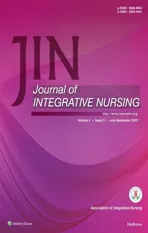Research capacity and training needs of nurses’ in Shanghai, China: A multicenter, cross-sectional survey
2022-10-10HuajiaoXUYingSHENLinglingWUWeihongSHEN
Huajiao XU, Ying SHEN, Lingling WU, Weihong SHEN
Department of Nursing, Jinshan Hospital of Fudan University, Shanghai, China
Research capacity and training needs of nurses’ in Shanghai, China: A multicenter, cross-sectional survey
Huajiao XU, Ying SHEN, Lingling WU, Weihong SHEN
Department of Nursing, Jinshan Hospital of Fudan University, Shanghai, China
ABSTRACTAims:The aim of this study is to investigate nurses’ research capacity and related training needs in Shanghai to provide evidence to further nursing research training.Materials and Methods:A cross-sectional design with a convenience sample of 1226 clinical registered nurses, including the Nursing Research Capacity of Self-Evaluation Questionnaire and Research Training Needs Form, was recruited from 14 public hospitals in Shanghai, China. And the influencing factors of nurses’ research capacity were analyzed.Results:The mean score of nurses’ research capacity was (46.25 ± 22.90) in Shanghai, that was at a low-to-medium level. The influencing factors of nurses’ research capacity including age (F= 15.983,P< 0.001), education (F= 20.738,P< 0.001), professional title (F= 6.993,P= 0.001), working years (F= 7.803,P< 0.001), department (F= 8.545,P< 0.001), and position (F= 3.354,P= 0.001). The most critical factor is the time to participate a study (P< 0.001). And what the nurses demanded were writing skills, special lectures, and participating in colleagues’ projects mostly.Conclusion:Nurse’s scientific research capacity still needs to be improved in Shanghai. The key to improving this situation is the individualized scientific research training and education for nurses and the practice of more participation in scientific research projects.
Keywords:Education, influencing factors, nurses, research capacity, training needs, writing skills
Address for correspondence:Ying SHEN, No. 1508, Longhang Road, Jinshan District, Shanghai, China.
E‑mail: shenying13412022@163.com
Submitted:13-Apr-2022
Revised:20-Jul-2022
Accepted:22-Jul-2022
Published:29-Sep-2022
This is an open access journal, and articles are distributed under the terms of the Creative Commons Attribution-NonCommercial-ShareAlike 4.0 License, which allows others to remix, tweak, and build upon the work non-commercially, as long as appropriate credit is given and the new creations are licensed under the identical terms.
For reprints contact:WKHLRPMedknow_reprints@wolterskluwer.com
How to cite this article:Xu H, Shen Y, Wu L, Shen W. Research capacity and training needs of nurses' in Shanghai, China: A multicenter, cross-sectional survey. J Integr Nurs 2022;4:120-6.
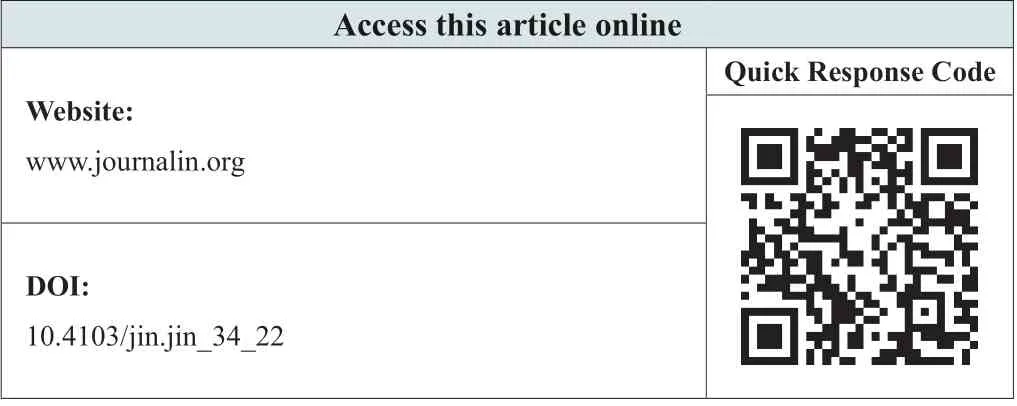
Access this article online Quick Response Code Website:www.journalin.org DOI:10.4103/jin.jin_34_22images/BZ_19_966_2775_1202_3011.png
INTRODUCTION
Nursing is significant to meeting the challenges posed by demographic changes and rising healthcare demands.[1]Research capacity which can be defined as the ability to conduct, utilize, and sustain research within a professional group is crucial to the nursing profession and is also essential to promote the sustainable development of the best nursing care.[2]Nursing research refers to the exploration of clinical nursing practice, nursing evaluation, nursing management, and nursing education by utilizing scientific methods.[3]As the main force in nursing research, clinical nurses’ research ability determines the level and development of nursing research.[4]
A global analysis indicated that China ranking seventh by total publications in 2000-2019 showed a rapidly developing trend on nursing research.[5]Over the last two decades, some achievements have been made in nursing research in China. However, there is still a big gap with other countries including the USA, the UK, Australia, and Canada, the average citation per paper of China in 2010-2019 was still lower than the global level.[5]The overall level of the Chinese nursing staff’s research capacity is still insufficient, and clinical nurses have strong research training needs.[6-8]Great difficulties and challenges are still existing in Chinese nursing research, such as clinical nurses with weak awareness and low participation, poor paper quality, and others.[9]All these form a gap with the development of the nursing discipline.[10,11]
In recent years, there are multiple studies on nurses’ research capacity and its influencing factor which demonstrated varied results. National and international literature about the relationship between research capacity and research behaviors were very scarce. Moreover, the papers on high-quality and quantitative research about nursing research capacity in Shanghai are very precious. Therefore, the present investigation, by a multicenter, cross-sectional and fully quantified survey, was carried out with the aim of understanding the current status of research capacity and related training needs of nursing staff in Shanghai, and analyzing the influencing factors of research capacity containing demographic data and research behavior. This study will add to an understanding of the level of research capacity and training needs of nurses in Shanghai for the global scholars, and may also appeal the developing countries with weak nursing research to pay more attention to the training and education of their nurses’ research capacity.
MATERIALS AND METHODS
Design and setting
This study was a cross-sectional survey about research capacity and training needs of clinical nurses in Shanghai. Moreover, the differences in the research capacity of participants with different demographic characteristics or different research behavior were further studied.
The samples were determined by the convenient sampling method. A total of 1319 registered nurses (RNs) were recruited from 14 governmental hospitals in Shanghai, containing 10 roots-scale hospitals, three secondary hospitals, and a tertiary hospital. As located in the eastern part of China, Shanghai, is the largest economic center and trade port. Its economic, medical care, education, and scientific research levels are all at the leading level in China. In recent years, as the rapid growth of international cooperation, Shanghai, has become a magnificent international metropolis.
Participants
Inclusion and exclusion criteria
The inclusion criteria were clinical nurses who were RNs in the 14 specific hospitals, full-time employees for more than 1 year, and willing to participate in the study. Nurses with mental impairments, or nurses who were taking sick leave or maternity leave were excluded.
Sample size calculation
The estimation method of sample size in multivariate analysis was referred to determine the sample size of this study. N (sample size) is at least five to ten times of M (variable).[12]This survey contains a total of 59 items, which consist of 18 items from the Demographic Data and Research Behavior Form, 30 items from the Nursing Research Capacity of Self-Evaluation Questionnaire, and 11 items from Research Training Needs Form. According to this, the sample size was calculated to be 295-590 cases. Considering the 10% shedding rate, the required sample size was finally calculated no <325 cases.
Instruments
Demographic data and research behavior form
A self-designed form was used to obtain the participant’s demographic data and research behavior, which included age, gender, marital state, educational level, professional title, position, hospital grade, department, years in clinical career, research training experience, influence by colleague’s research projects, frequency of research activities, frequency of reading literature, frequency of sharing literature, frequency of participating in academic conferences, using the database, publishing papers, and hosting or participating in topics.
Nursing research capacity of self-evaluation questionnaire
Research capacity was measured by the Nursing Research Capacity of Self-Evaluation Questionnaire, which was designed to assess the level of research capacity of nurses.[13]There are six dimensions in the scale, which include problem discovery (3 items), literature retrieval (5 items), research design (5 items), research practice (6 items), data processing (5 items), and writing skills (6 items). Each item is assessed using a 5-point Likert-style scale from 0 (rarely capable) to 4 (completely capable). The total score ranges from 0 to 120, higher scores indicating a high level of research capacity (0-40 = research capacity of a low level, 41-80 = research capacity of a medium level, 81-120 = research capacity of a high level). The scale demonstrated good validity, with a Cronbach’s alpha of 0.861, ranging from 0.655-0.760 for the dimensions. In this study, the test-retest reliability was 0.899 on the basis of twice investigations after 2 weeks.
Research training needs form
Based on on Xie’s relevant investigation,[14]a self-designed form of nurses’ research training needs was produced. The form involves 11 items, whose replies were binary variables (Yes or No).
Data collection
The researcher asked permission from the directors of the nursing department in each hospital. And then, the inclusion and exclusion criteria of samples were informed to the corresponding management department in detail. After informed consent was obtained on the nurse’s agreement to participate in the study, the questionnaires were distributed via the Questionnaire Star Platform in anonymous form. At the call of the directors, the participants were needed to complete the questionnaires based on their actual situation within 7 days after distribution. The integrity of the completed questionnaires was checked by the researchers. The questionnaires that were repeatedly submitted at the same IP address, or with the proportion of missing information exceeding 20%, or with the response time of <3 min were excluded. In addition, the researchers tested the consistency and logic of the data.
Statistical analysis
All data were exported from the Questionnaire Star Platform to excel table to establish the original database. After logic error monitoring and eliminating invalid questionnaires, the remaining data were imported in SPSS 22.0 statistical software which was developed by International Business Machines Corporation located in New York, USA. Descriptive statistics were used to describe the demographic characteristics, research behavior, research capacity, and training needs of the participants. Two-samplet-test and the ANOVA test were performed to detect the differences in the research capacity of participants with different demographic characteristics or different research behavior. AP< 0.05 was considered statistically significant.
Ethical considerations
This study was approved by the Ethics Board of Jinshan Hospital of Fudan University on February 11, 2022 (approval number NO. JIE 2021-S13). The eligible participants were informed in the consent form regarding the study and a written consent form was obtained before the study. It was highlighted to the participants that participation in this study was voluntary and their refusal to participate in the study would not lead to any negative consequences. The anonymity and confidentiality of the responses were protected in the study.
RESULTS
A total of 1319 eligible nurses who met the study criteria were approached. Of these, 1226 participants consented and completed the qualified questionnaires. The effective rate of the questionnaires was 92.9% (1226/1319).
Level of research capacity
The participants’ research capacity scores in this study are summarized in Table 1. The research capacity scores of clinical nurses ranged from 0 to 120, with a mean score of (46.25 ± 22.90). The overall research capacity of clinical nurses was at a medium-to-low level. The item mean score of each dimension from the lowest to the highest was data processing (1.36 ± 0.88), research design (1.38 ± 0.88), writing skills (1.47 ± 0.89), research practice (1.48 ± 0.88), literature review (1.74 ± 0.76), and problem discovery (2.05 ± 0.76), respectively.
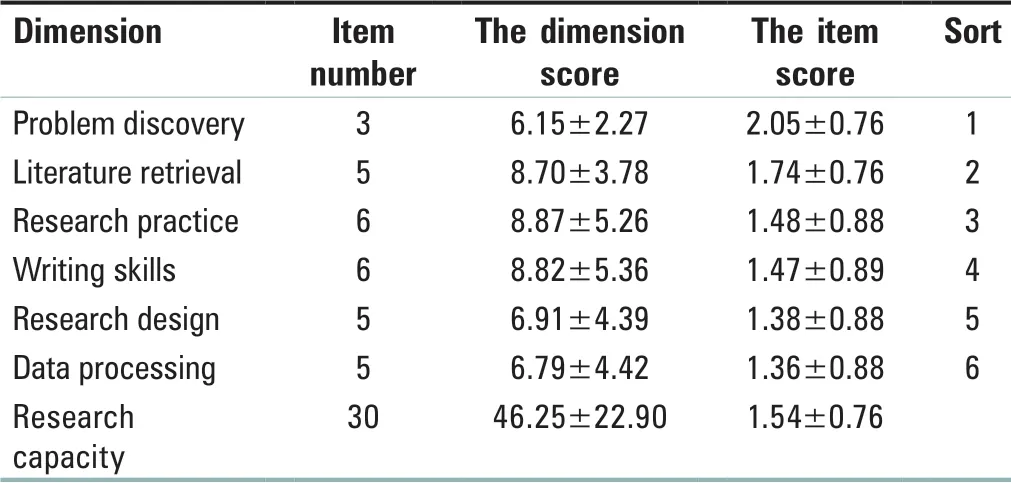
Table 1: Level of research capacity of clinical nurses (n=1226)
Comparison of clinical nurses’ research capacity
Two-samplet-test and the ANOVA test were performed to detect the differences in the research capacity of participants with different demographic characteristics or different research behavior.
As shown in Table 2, there were significant differences in the research capacity scores among clinical nurses with different age (F= 15.983,P< 0.001), different educational level (F= 20.738,P< 0.001), different department (F= 8.545,P< 0.001), different professional title (F= 6.993,P= 0.001), different position (t= -3.354,P= 0.001), and different years in clinical career (F= 7.803,P< 0.001).
Table 3 indicates that the more frequent the research behavior, the higher the level of research capacity (P< 0.001), including research courses learning, influence by colleague’s projects, participating in research activities, reading and sharing literature, participating in academic conferences, using database, publishing papers, and hosting or participating in topics.

Table 2: Comparison of research capacity of nurses with different demographic characteristics (n=1226)
Research training needs of clinical nurses
As described in Figure 1, different degrees of research training needs are required. The three items with the highest training need rates were writing skills (49.10%), special lectures (44.37%), and participating in colleague’s projects (42.66%). The three items with the lowest training need rates were literature retrieval (39.23%), research design (39.80%), and group discussion (39.80%).
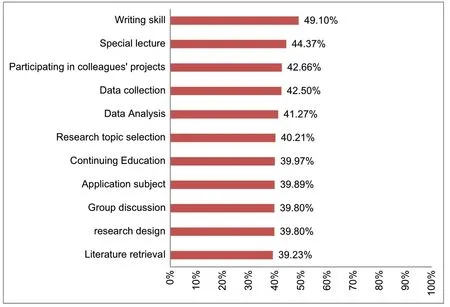
Figure 1: Research training needs rate of clinical nurses
DISCUSSION
The research capacity of nursing staff in Shanghai needs to be improved
This study investigated 1226 RNs from 14 public hospitals in Shanghai. The results showed that the mean score of nursing staff in this area was (46.25 ± 22.90), which was at a low-to-medium level. According to the percentile scoring method, the investigators calculated a standardized score of 38.54 points for the research capacity of nurses, which was higher than that of 27335 nurses in 22 provinces and cities (38.54 vs. 25.00) from Shang’s survey.[6]The principal reason of this situation may be the account of the low education level, which may limit nurse’s involvement in research.[15]This investigation also found that the score of each dimension from the highest to the lowest was problem discovery, literature retrieval, research practice, writing skills, research design, and data processing. It can be seen that the nurses in Shanghai had a relatively strong ability to find problems, consult literature, and research practice while their paper writing, data processing, and research design ability were relatively weak, which was basically consistent with the relevant research results.[16-18]The reason may be that the education level of the nursing staff in China is uneven. With the demand for higher quality nursing care, the China government has been increasing the investment in medical education to improve the educational structure for nurses.[19]Although a large part of the staff completed college or undergraduate education through adult education after work. However, they are still lack of systematic and standardized nursing research training.[11]Zhang indicated the current level of nursing research capacity in China is not ideal, lack of systematic research training was a major barrier to nurses’ research participation and involvement.[8]The situation in Shanghai is generally similar. The overall educational level of nursing staff is low, and plenty of nurses have not received systematic research training. Therefore, although nursing staff in this area are capable of perceiving problems while their work and consulting related literature, they are still poor in paper writing, research design and data processing due to limited research knowledge.
Influencing factors of clinical nurse’s research capacity
Previous studies showed that research capacity may be determined by some individual and organizational factors, such as educational level, position, and support level.[20,21]As described in Table 2, on the aspect of demographic material, the influence factors of clinical nurse’s research capacity were age, educational level, professional titles, years in clinical career, department, and positions (P< 0.01). Nursing staff with low age, less years in clinical career, high education, senior professional title or head nurses have been found with stronger research capacity. The age and years in the clinical career of nursing staff showed a negative trend with their research capacity. Those aged ≤30 years and years in clinical career ≤5 years had the highest score of research capacity. This conclusion was consistent with Luo’s research,[22]but was the opposite of Robichaud-Ekstrand’s conclusion.[23]The diversity was owed to different national situations between the two studies. In China, the first degree of young nurses is usually college or undergraduate, with more opportunities to receive systematic research courses during school. However, elder nurses are mostly graduates from nursing schools without any research training. In addition, young nurses with clear career planning are less hampered by family chores, and have more energy to engage in nursing research. This study also indicated that nurses with senior titles or administrative positions had a relatively high level of research capacity. As shown in Jiang’s study, the position was a influence factor of the research capacity, clinical nurses with higher positions reported a high level of research capacity.[7]On the one hand, it is because there is a certain demand for research output for this population. On the other hand, most of these people are nursing managers, and their own research consciousness is relatively strong.[24]However, the clinical frontline nurses with heavy nursing tasks are usually lack of time for research projects, lack of formal research training, and lack of research knowledge and methods.[25]In this study, there were also statistical differences in the research capacity scores of nurses in different departments. The scores of nurses in internal medicine and administrative posts were higher while those of nurses in auxiliary departments were the lowest. Via investigation, the research capacity of 1199 specialist nurses in Hubei Province, China, Wang found that the research capacity of specialist nurses was related to their gender, education level, professional title, and hospital grade, but not to their age, years in clinical career and position.[16]Wang’s conclusion is different from that of this study, which may be related to the different research objects and regions.
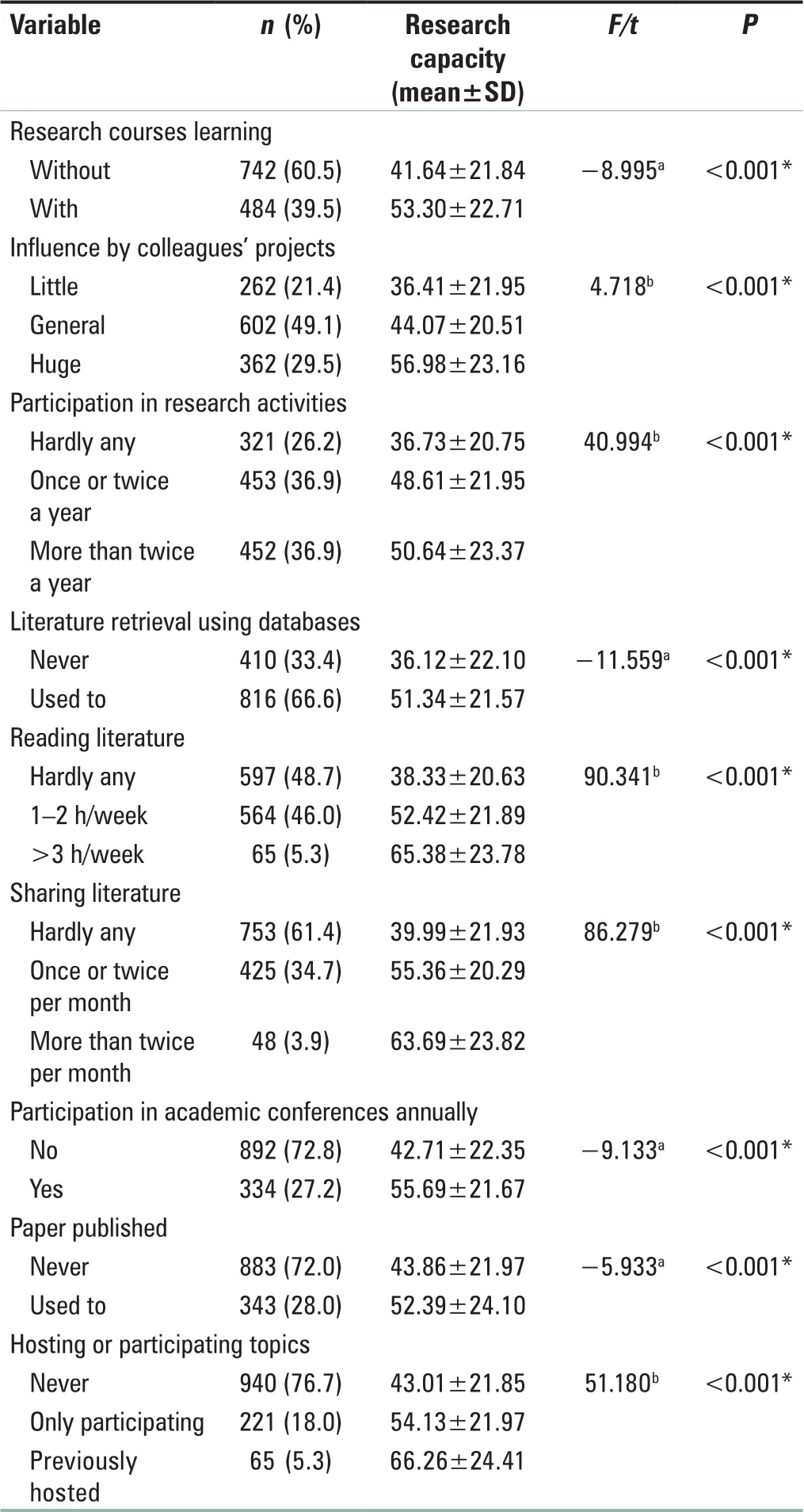
Table 3: Comparison of research capacity of nurses with different research behavior (n=1226)
Based on Table 3, this survey revealed that the score of nursing staff’s research capacity was related to their research education courses, the degree of influence by colleagues projects, the frequency of participating in research activities, their ability to consult literature through the database, the quantity of reading literature, the frequency of sharing literature, participating in academic conferences, the experience of publishing papers, and hosting or participating in topics. It indicates that the more frequent the behavior related to scientific research, the higher the level of scientific research capacity. To improve nursing staffs’ research capacity, they should be encouraged to participate in various research activities. Currently, few articles have reported the correlation between nurse’s research capacity and research behavior, so further relevant research is required to support our conclusion.
Research training needs of nursing staff
The nursing staff in Shanghai have strong research training needs, of which the three highest demands were writing skills (49.10%), special lectures (44.37%), and participating in colleague’s projects (42.66%), the three lowest demands were literature retrieval (39.23%), research design (39.80%) and group discussion (39.80%). On the one hand, the current nursing professional title promotion system in China determines the requirements for the publication of papers. In this study, the respondents with intermediate and primary titles account for 75.6% and 23.5%, respectively. Combined with the policies of this area, all the nurses need to publish the papers when they are promoted to senior posts or regularly assessed. However, there is no requirement for the subject. Therefore, the nursing staff with primary and intermediate titles in this area have a high demand for writing papers, and only a general demand for the application of topics. On the other hand, it presented that in Table 2, most nursers in this area without systematic research education had less participation in research academic conferences regularly and research experience. As a result, their scientific research skills are weak, and lack of confidence. However, both the scientific research design and the group discussion have high requirements for the scientific research level of the participants, and the group discussion needs to take the initiative to think, and the preparation before the discussion is complex. Therefore, most personnel prefer to improve their research ability by participating in special lectures and other topics, and have low demand for scientific research design and group discussion. In addition, 66.6% of the 1226 respondents had used the databases for literature retrieval. It indicated that the literature retrieval ability of nurses in this area was still acceptable, so their demand for literature retrieval training was low.
Xie used the same questionnaire to investigate the research needs of nurses. His results showed that the three items of higher scientific research needs of 577 nursing staff were “application subject,” “writing skill” and “special lectures,” and the three items of lower research needs were “continuing education,” “literature retrieval” and “group discussion.”[14]The conclusions are highly similar to those of this survey.
Limitations
The participants recruited from the same region may limit the generalization of the results. Considering the validity of the conclusion, future research should include nurses diverse geographical regions. Moreover, self-report measures in the current study might limit the accuracy of responses. It is possible that response bias and the attitude of participants might affect the results of this study. Future research is suggested to use multiple measures, as well as peer rating, to assess the variables.
CONCLUSION
The research capacity of nursing staff in Shanghai is at a low-to-medium level. The influencing factors of research capacity contain age, education level, professional title, years in clinical career, department, and position. Meanwhile, the nurses who take part in various research behaviors frequently have a higher level of scientific research capacity. Moreover, nursing staff have strong research training needs, especially those on writing skills, special lectures and participating in colleague’s projects.
Nursing research plays a critical role in promoting the development of nursing discipline. In Shanghai, the insufficient of research capacity hinders the research practice. Thus, there is great significance to carry out nursing research training. Moreover, the related course should conform to nurses’ needs, their individual characteristics and research capacity level. Furthermore, we also highly recommend that the research training courses should be layered, targeted and combined with research practice.
Financial support and sponsorship
This study was supported by Youth Research Initial Fund of Jinshan Hospital Fudan University (JYQN-LC-202105) and Jinshan District Science and Technology Commission Fund (2021-3-10).
Conflicts of interest
There are no conflicts of interest.
REFENENCES
1. The Lancet. 2020: Unleashing the full potential of nursing. Lancet 2019;394:1879.
2. Hoffman AJ, Spoelstra S, Wierenga K,et al. Midwest nursing research society news. West J Nurs Res 2018;40:1919-26.
3. Polit DF, Beck CT. Essentials of Nursing Research Appraising Evidence for Nursing Practice. 10thed. London: Lippincott Williams & Wilkins; 2017.
4. Shen Y, Wan YH, Sun X,et al. Construction of hierarchical evaluation index system on scientific research ability for clinical nurses. J Nurs Sci 2020;35:73-6.
5. Yanbing S, Hua L, Chao L,et al. The state of nursing research from 2000 to 2019: A global analysis. J Adv Nurs 2021;77:162-75.
6. Shang SM, Wu X, Gao YH,et al. Investigation of nurses’scientific research competency and training demand in Chinese tertiary hospitals. Chin J Nurs 2018;53:277-80.
7. Jiang W, Yuan Y, Zhang L. Self-efficacy and research capacity of clinical nurses in China. J Contin Educ Nurs 2019;50:509-16.
8. Zhang J, Yan QY, Yue S. Nursing research capacity and its management in China: A systematic review. J Nurs Manag 2020;28:199-208.
9. Zhu Y, Zhang JC. Relationship between research ability and professional identity among nurses. J Nurs Sci 2019;34:61-3.
10. Dai HM, Wu HY, Xing YZ. Investigation of research ability among nursing staff and the influencing factors. J Nurs Sci 2015;30:60-3.
11. Ge YR, Yan SY, Zhao LL,et al. The application of action research method in scientific research ability training for nursing. Chin J Nurs 2016;51:75-9.
12. Ni P, Chen JL, Liu N. Sample size estimation of quantitative research in nursing research. Chin J Nurs 2010;45:378-80.
13. Pan YH. Develpment of a Revised Version of Nursing Research Capacity of Self-Evaluation Questionnire. Shanxi: Shanxi Medical University; 2011.
14. Xie JH, Zhu LH, Liu HY,et al. Status quo of research ability and research needs of 577 nurses. Chin J Mod Nurs 2020;26:4489-94.
15. Wang CC, Whitehead L, Bayes S. Nursing education in China: Meeting the global demand for quality healthcare. Int J Nurs Sci 2016;3:131-6.
16. Wang X, Li XY. Investigation of scientific research ability of clinical nursing pecialist. J Nurs Sci 2020;35:87-9.
17. Peng JY, Zhou YM, Gao SP,et al. Investigation and analysis of nurses’ scientific research ability in tertiary hospitals of Xiangyang. Chongqing Med 2020;49:298-301.
18. Zhou YM, Xu HL, Peng JY,et al. Application of workshop model in a training program for nurses’scientific research ability in tertiary hospital. J Nurs Sci 2020;35:60-2, 73.
19. Zhan Q, Shang S, Li W,et al. Bridging the GP gap: Nurse practitioners in China. Lancet 2019;394:1125-7.
20. Dorgan S. Building research capacity and capability in the nursing, midwifery and allied health professions. Br J Nurs 2018;27:634-5.
21. Duffy JR, Culp S, Yarberry C,et al. Nurses’ research capacity and use of evidence in acute care: Baseline findings from a partnership study. J Nurs Adm 2015;45:158-64.
22. Luo ZT, Hu H, Pang SQ,et al. Research on the correlation between research capacity and self-efficacy of nursing research among nursing graduate students in Traditional Chinese medicine universities. J Nurs Adm 2020;20:476-80.
23. Robichaud-Ekstrand S. New Brunswick nurses’ views on nursing research, and factors influencing their research activities in clinical practice. Nurs Health Sci 2016;18:246-55.
24. Jamerson PA, Vermeersch P. The role of the nurse research facilitator in building research capacity in the clinical setting. J Nurs Adm 2012;42:21-7.
25. Kelly KP, Turner A, Gabel Speroni K,et al. National survey of hospital nursing research, part 2: Facilitators and hindrances. J Nurs Adm 2013;43:18-23.
杂志排行
Journal of Integrative Nursing的其它文章
- Nursing perspective of expert consensus on the diagnosis and treatment of cerebral infarction with integrated traditional Chinese and Western medicine
- Does educational intervention change knowledge, attitude, and practice regarding pharmacovigilance among nursing officers in Central lndia? An interventional study
- Referral and counter-referral practices in obstetric emergencies among health-care providers in selected health facilities in Plateau state, Nigeria
- Nurses and nursing students’ knowledge regarding blood transfusion: A comparative cross-sectional study
- Practice and patronage of traditional bonesetting in Ondo State, Nigeria
- Faculty of health sciences students’ knowledge and attitudes toward coronavirus disease 2019 during the first wave of the pandemic: A cross-sectional survey
